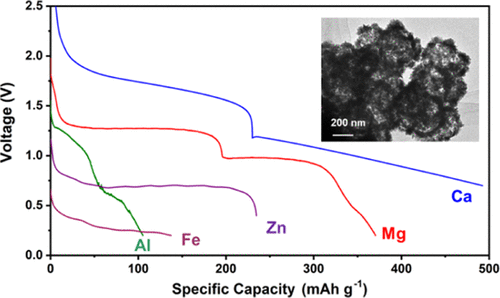当前位置:
X-MOL 学术
›
ACS Appl. Mater. Interfaces
›
论文详情
Our official English website, www.x-mol.net, welcomes your
feedback! (Note: you will need to create a separate account there.)
Hierarchical Copper Sulfide Porous Nanocages for Rechargeable Multivalent-Ion Batteries.
ACS Applied Materials & Interfaces ( IF 8.3 ) Pub Date : 2020-02-19 , DOI: 10.1021/acsami.9b21999 Wen Ren 1, 2 , Fangyu Xiong 1 , Yuqi Fan 1 , Yuli Xiong 3 , Zelang Jian 1
ACS Applied Materials & Interfaces ( IF 8.3 ) Pub Date : 2020-02-19 , DOI: 10.1021/acsami.9b21999 Wen Ren 1, 2 , Fangyu Xiong 1 , Yuqi Fan 1 , Yuli Xiong 3 , Zelang Jian 1
Affiliation

|
Copper sulfide (CuS) has been identified as a promising positive electrode material for some multivalent-ion batteries (such as the magnesium-ion battery) because of its high theoretical capacity, environmental friendliness, and wide availability. However, the clumsy multivalent-ion with high polarity inclines toward sluggish ion insertion/de-insertion, leading to inadequate electrochemical performance. In this work, the hierarchical CuS porous nanocages are successfully fabricated via a facile one-step room-temperature liquid-phase process and evaluated as positive electrode materials for rechargeable magnesium batteries. Owing to the structural advantages, a high reversible magnesium storage capacity of 228 mA h g-1 is attained, which is superior to the previously reported results under similar conditions. Besides, the application of CuS as positive electrode materials for calcium-ion, zinc-ion, iron-ion, and aluminum-ion batteries is investigated. The hierarchical CuS porous nanocages display promising electrochemical performance in those multivalent-ion battery systems. Our work proves the superiority of the nanostructure design in improving the electrochemical performance of positive electrode materials for multivalent-ion batteries.
中文翻译:

用于可充电多价离子电池的分层硫化铜多孔纳米笼。
硫化铜(CuS)具有较高的理论容量,环境友好性和广泛的可用性,因此已被认为是某些多价离子电池(例如镁离子电池)有希望的正极材料。然而,具有高极性的笨拙的多价离子倾向于缓慢的离子插入/去插入,导致电化学性能不足。在这项工作中,通过简便的一步式室温液相工艺成功地制备了分级CuS多孔纳米笼,并被评估为可充电镁电池的正极材料。由于结构上的优势,获得了228 mA h g-1的高可逆镁存储容量,这优于先前报道的在类似条件下的结果。除了,研究了CuS作为钙离子,锌离子,铁离子和铝离子电池正极材料的应用。分层的CuS多孔纳米笼在那些多价离子电池系统中显示出有希望的电化学性能。我们的工作证明了纳米结构设计在改善多价离子电池正极材料的电化学性能方面的优越性。
更新日期:2020-02-20
中文翻译:

用于可充电多价离子电池的分层硫化铜多孔纳米笼。
硫化铜(CuS)具有较高的理论容量,环境友好性和广泛的可用性,因此已被认为是某些多价离子电池(例如镁离子电池)有希望的正极材料。然而,具有高极性的笨拙的多价离子倾向于缓慢的离子插入/去插入,导致电化学性能不足。在这项工作中,通过简便的一步式室温液相工艺成功地制备了分级CuS多孔纳米笼,并被评估为可充电镁电池的正极材料。由于结构上的优势,获得了228 mA h g-1的高可逆镁存储容量,这优于先前报道的在类似条件下的结果。除了,研究了CuS作为钙离子,锌离子,铁离子和铝离子电池正极材料的应用。分层的CuS多孔纳米笼在那些多价离子电池系统中显示出有希望的电化学性能。我们的工作证明了纳米结构设计在改善多价离子电池正极材料的电化学性能方面的优越性。


















































 京公网安备 11010802027423号
京公网安备 11010802027423号